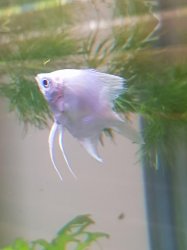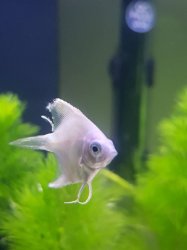Hi and welcome to the forum

How long has the tank been set up for?
Have you tested the water quality for ammonia, nitrite, nitrate & pH?
If yes, what are the results in numbers?
How often do you do water changes and how much water do you change?
Do you gravel clean the substrate when you do a water change?
Do you dechlorinate the water before adding it to the tank?
--------------------------
The dwarf gourami, mollies and guppies did not do this.
--------------------------
The fish in the picture is skinny and appears to have fin rot and fungus on the dorsal (top) fin. The tail is clamped and so are the pectoral (side) fins. This is an indication of poor water quality. If the water in your aquarium is good then the fish was unwell when you got it.
If you do a 75% water change and gravel clean the substrate each day for a week it should help with the fin rot. However, you will need to treat the fish for fungus. You can try salt first, see directions below. If there is no improvement after a few days with salt in the water then get a broad spectrum fish medication that treats fungus, bacteria and protozoan infections should be fine. But try salt first because it is safer.
--------------------------
SALT as a Treatment.
You can add rock salt (often sold as aquarium salt), sea salt or swimming pool salt to the aquarium at the dose rate of 1 heaped tablespoon per 20 litres of water. If there is no improvement after 48 hours you can double that dose rate so there is 2 heaped tablespoons of salt per 20 litres.
If you only have livebearers (guppies, platies, swordtails, mollies), goldfish or rainbowfish in the tank you can double that dose rate, so you would add 2 heaped tablespoons per 20 litres and if there is no improvement after 48 hours, then increase it so there is a total of 4 heaped tablespoons of salt per 20 litres.
Keep the salt level like this for at least 2 weeks but no longer than 4 weeks otherwise kidney damage can occur. Kidney damage is more likely to occur in fish from soft water (tetras, Corydoras, angelfish, gouramis, loaches) that are exposed to high levels of salt for an extended period of time, and is not an issue with livebearers, rainbowfish or other salt tolerant species.
The salt will not affect the beneficial filter bacteria but the higher dose rate will affect some plants. The lower dose rate will not affect plants.
After you use salt and the fish have recovered, you do a 10% water change each day for a week. Then do a 20% water change each day for a week. Then you can do bigger water changes after that.
--------------------------
To work out the volume of water in the tank:
measure length x width x height in cm.
divide by 1000.
= volume in litres.
When you measure the height, measure from the top of the substrate to the top of the water level.
There is a calculator/ converter in the "How To Tips" at the top of this page that will let you convert litres to gallons if you need it.
Remove carbon from the filter before treating or it will absorb the medication and stop it working.
Wipe the inside of the glass down, do a 75% water change and complete gravel clean. And clean the filter before treating. Make sure any new water is free of chlorine/ chloramine before it is added to the tank.
Increase surface turbulence/ aeration when using medications because they reduce the dissolved oxygen in the water.




